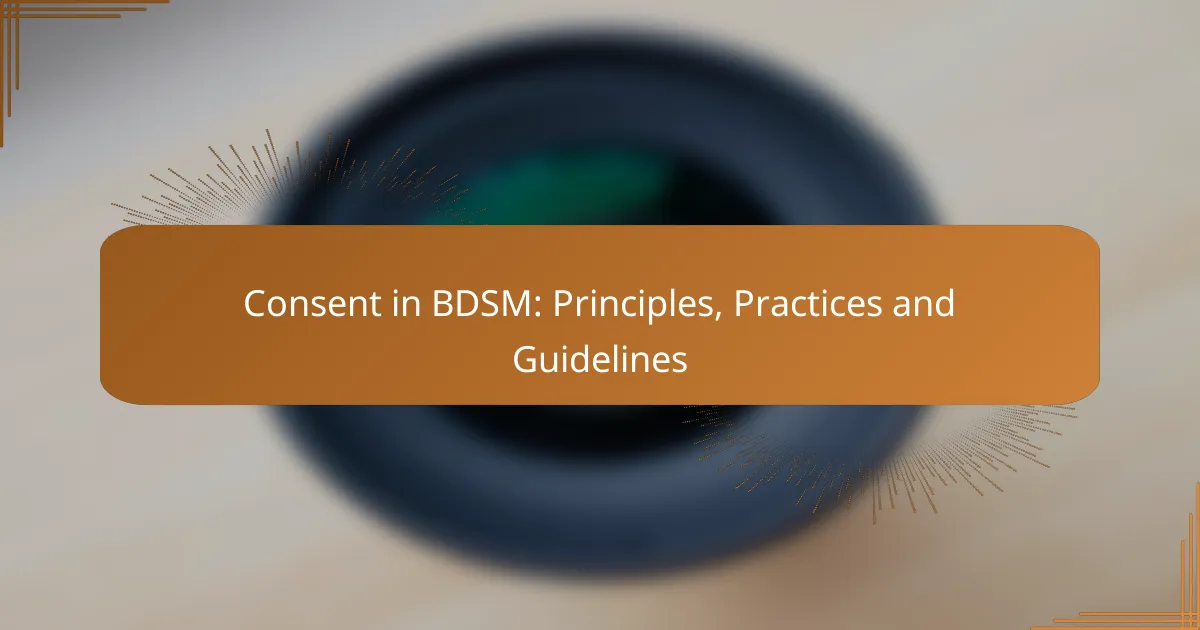Consent in [censured] is foundational, emphasizing mutual agreement, understanding, and respect among participants. It requires clear communication and ongoing negotiation of boundaries, ensuring that everyone involved feels safe and empowered. By establishing practices such as safe words and defined roles, individuals can engage in their experiences with confidence and clarity.
![What are the principles of consent in [censured]?](/wp-content/uploads/what-are-the-principles-of-consent-in-[censured]-1.webp)
What are the principles of consent in [censured]?
The principles of consent in [censured] revolve around mutual agreement, understanding, and respect between all parties involved. Consent must be informed, negotiated, ongoing, and can be revoked at any time, ensuring that all participants feel safe and empowered throughout their experience.
Informed consent
Informed consent means that all parties have a clear understanding of what activities will take place, the risks involved, and the potential emotional and physical impacts. Participants should discuss their limits, desires, and any relevant health issues before engaging in [censured] practices.
To ensure informed consent, consider providing written agreements or checklists that outline expectations and boundaries. This transparency helps build trust and reduces misunderstandings.
Negotiation
Negotiation is a crucial step in establishing consent, as it allows participants to openly discuss their interests, limits, and safe words. This dialogue should occur before any scene begins and can include specific activities, duration, and aftercare preferences.
Effective negotiation often involves active listening and a willingness to compromise. Both parties should feel comfortable expressing their needs and concerns, fostering a collaborative atmosphere.
Ongoing consent
Ongoing consent emphasizes that consent is not a one-time agreement but a continuous process. Participants should regularly check in with each other during a scene to ensure that everyone remains comfortable and willing to proceed.
Establishing a culture of ongoing consent can involve verbal check-ins or non-verbal cues. This practice helps maintain a safe environment and allows for adjustments as needed.
Safe words
Safe words are predetermined words or signals that participants can use to pause or stop an activity if they feel uncomfortable or overwhelmed. Choosing a safe word that is easy to remember and unlikely to be used in regular conversation is essential.
Common safe words include “red” for stop, “yellow” for slow down, and “green” for go ahead. Participants should agree on these terms during negotiation and respect them without question.
Power dynamics
Power dynamics play a significant role in [censured], as they involve the consensual exchange of power between participants. Understanding these dynamics is crucial for ensuring that consent remains informed and ongoing.
Participants should discuss their roles, whether dominant or submissive, and how these roles affect consent. Acknowledging the inherent power imbalances can help mitigate risks and enhance the experience for everyone involved.
![How to establish consent in [censured] practices?](/wp-content/uploads/how-to-establish-consent-in-[censured]-practices-2.webp)
How to establish consent in [censured] practices?
Establishing consent in [censured] practices involves clear communication and mutual agreement between all parties involved. This ensures that everyone understands their roles, boundaries, and expectations before engaging in any activities.
Pre-scene discussions
Pre-scene discussions are crucial for establishing consent in [censured]. These conversations should cover desires, limits, and safe words, ensuring all participants are on the same page. It’s important to discuss both physical and emotional boundaries to create a safe environment.
During these discussions, participants should openly express their interests and any past experiences that may influence their comfort levels. This transparency fosters trust and helps prevent misunderstandings during the scene.
Written agreements
Written agreements can serve as a formal record of consent in [censured] practices. While not legally binding, they outline the terms of the relationship, including specific activities, limits, and safe words. This can be particularly useful in ongoing relationships where dynamics may evolve over time.
When creating a written agreement, both parties should review and sign it, ensuring that they fully understand and agree to the terms. Regularly revisiting and updating the agreement can help maintain clarity and consent as preferences change.
Verbal affirmations
Verbal affirmations are essential during [censured] scenes to confirm ongoing consent. Participants should regularly check in with each other, using clear language to express comfort or discomfort. This practice reinforces the importance of consent throughout the experience.
Incorporating safe words is a key aspect of verbal affirmations. These words should be easy to remember and distinct from regular conversation. Establishing a clear protocol for using safe words can help ensure that all parties feel secure and respected during the scene.
![What are common practices for obtaining consent in [censured]?](/wp-content/uploads/what-are-common-practices-for-obtaining-consent-in-[censured]-3.webp)
What are common practices for obtaining consent in [censured]?
Common practices for obtaining consent in [censured] include clear communication, negotiation of boundaries, and establishing safe words. These practices ensure that all parties understand their roles and limits, fostering a safe environment for exploration.
Role-play scenarios
Role-play scenarios in [censured] often involve pre-agreed dynamics and characters, which require explicit consent from all participants. Before engaging, partners should discuss their roles, the context of the scenario, and any specific actions that are permissible or off-limits.
For example, if one partner wants to act as a dominant and the other as a submissive, they should clarify what behaviors are acceptable and what triggers might require a pause or stop. This negotiation helps prevent misunderstandings and enhances the experience.
Check-in protocols
Check-in protocols are essential during [censured] activities to ensure ongoing consent and comfort. Partners should establish regular intervals to communicate about their feelings and experiences, allowing for adjustments as needed.
For instance, a simple thumbs-up or down can serve as a quick check-in during a scene. More in-depth discussions can occur at designated moments, such as after a specific activity or at the halfway point of a session.
Aftercare discussions
Aftercare discussions are crucial for processing the experience and ensuring emotional well-being post-scene. This involves talking about what went well, any feelings that arose, and any physical needs that should be addressed.
Partners should share their thoughts on the scene and discuss any aspects that may need adjustment for future encounters. This can help reinforce trust and improve future experiences, making aftercare an integral part of the consent process in [censured].
![What guidelines should be followed for consent in [censured]?](/wp-content/uploads/what-guidelines-should-be-followed-for-consent-in-[censured]-4.webp)
What guidelines should be followed for consent in [censured]?
Consent in [censured] is fundamental and should always be informed, enthusiastic, and revocable. Practitioners must establish clear agreements regarding boundaries, safe words, and aftercare to ensure a safe and respectful experience for all parties involved.
Community standards
Community standards in [censured] emphasize the importance of communication and mutual respect. Many practitioners follow the principles of SSC (Safe, Sane, and Consensual) or RACK (Risk-Aware Consensual Kink), which guide interactions and help establish a culture of safety and responsibility.
Engaging with local [censured] communities can provide valuable insights into accepted practices and norms. Participating in workshops or discussions can enhance understanding of consent and help individuals navigate their experiences more effectively.
Legal considerations
Legal considerations surrounding consent in [censured] vary by jurisdiction, but it is crucial to understand that consent does not absolve individuals from legal liability in cases of harm. In many places, consent may not be a valid defense against charges of assault or other offenses, particularly if injuries occur.
Practitioners should familiarize themselves with local laws regarding consent, especially when engaging in activities that may cause physical harm. Consulting legal resources or professionals can help clarify the implications of consent in [censured] practices within specific regions.
![How does consent vary across different [censured] communities?](/wp-content/uploads/how-does-consent-vary-across-different-[censured]-communities-5.webp)
How does consent vary across different [censured] communities?
Consent in [censured] varies significantly across different communities, influenced by local customs, cultural norms, and individual practices. Each community may have its own understanding of what constitutes informed and enthusiastic consent, which can affect how practitioners engage in [censured] activities.
Regional differences
Regional differences in [censured] consent practices can be notable, as local laws and societal attitudes shape how consent is understood and communicated. For instance, in some European countries, there may be a stronger emphasis on written agreements, while in the United States, verbal consent and ongoing negotiation are often prioritized. Understanding these regional nuances is essential for practitioners to navigate consent effectively.
In areas where [censured] is more publicly accepted, such as parts of Western Europe, there may be more open discussions about consent and safety practices. Conversely, in regions where [censured] is stigmatized, practitioners might adopt more discreet methods of establishing consent, which can lead to misunderstandings if not clearly communicated.
Cultural influences
Cultural influences play a significant role in shaping consent practices within [censured] communities. In cultures that emphasize individualism, such as in North America, there may be a strong focus on personal autonomy and explicit consent. This can lead to detailed discussions about boundaries and safe words before engaging in any activities.
In contrast, cultures that prioritize collectivism may approach consent differently, often relying on established norms and group consensus rather than individual negotiation. This can create challenges, as the expectations around consent may not align with those from more individualistic cultures, potentially leading to conflicts or misunderstandings.
![What are the risks of non-consensual [censured] practices?](/wp-content/uploads/what-are-the-risks-of-non-consensual-[censured]-practices-6.webp)
What are the risks of non-consensual [censured] practices?
Non-consensual [censured] practices can lead to significant emotional and legal risks for all parties involved. Engaging in [censured] without clear consent can result in psychological trauma and potential legal repercussions, depending on the jurisdiction.
Emotional harm
Emotional harm from non-consensual [censured] can manifest as anxiety, depression, and trust issues. Individuals may feel violated, leading to long-lasting psychological effects that can disrupt personal relationships and overall well-being.
To mitigate emotional risks, clear communication and established boundaries are essential. Practicing safe words and regular check-ins can help ensure that all parties feel secure and respected during [censured] activities.
Legal consequences
Engaging in non-consensual [censured] can lead to serious legal consequences, including criminal charges such as assault or battery. Laws vary by location, but many jurisdictions take a strict stance against any form of non-consensual activity.
It is crucial to understand local laws regarding consent and [censured] practices. Familiarizing oneself with these regulations can help prevent legal issues and ensure that all activities are conducted safely and within the bounds of the law.



